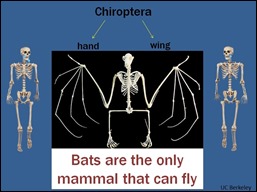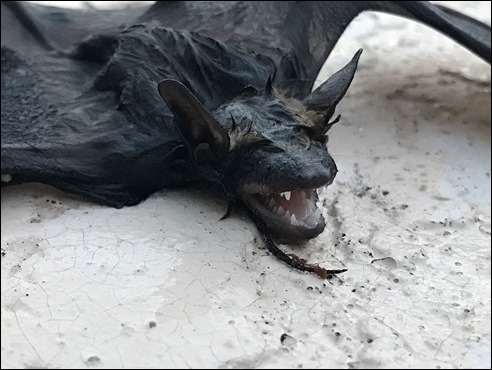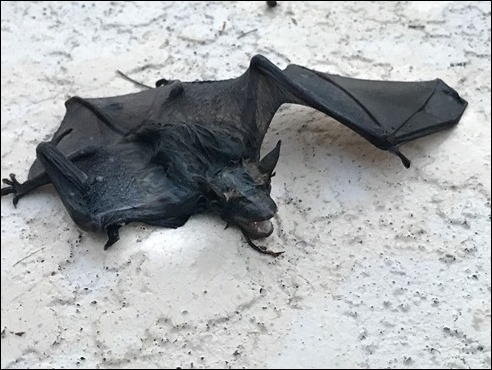Regularly see bats in the evening, but first time in the pool
Posted By RichC on July 25, 2021
So what do you know about bats?
Personally, I didn’t know very much at all. I see them regularly in the evening sky darting around and have always repeated the mantra that they are good for the environment because they  eat mosquitos and pesky insects (article). Beyond that … and the vampire stories … I really don’t know all that much except that the one in the pool has beautiful white teeth (so much for eating insects). We’ve had ducks, mice, rabbits, crawdads, snakes, etc in the pool, but this is a first time for a bat.
eat mosquitos and pesky insects (article). Beyond that … and the vampire stories … I really don’t know all that much except that the one in the pool has beautiful white teeth (so much for eating insects). We’ve had ducks, mice, rabbits, crawdads, snakes, etc in the pool, but this is a first time for a bat.
Last week after working in the yard late one evening, I jumped into the pool to cool off and freshen up before heading into the house. I ended up swimming with something doing the same although it wasn’t swimming, seeming to cling to one of the broken tiles at the end of the pool. It was dusk so it sort of looked like a large mouse or something but after some wave-making on my part, it washed back into the pool and tried to spread its wings. Hm, I’ve heard of “bats in the belfry” … a phrase for being crazy or eccentric … but not “bats in the pool.”
Of course a bit more attention has been given to bats since the Coronavirus pandemic since research in Wuhan China was focused on cave and bat viruses (or wet market theories if you of that line of thinking). Here at home, bats have often been associated with rabies, although it is far more likely a person will be bit by an infected dog, coyote, fox, skunk or raccoon than a bat.
As for our little half drown bat (not sure what specie) … I’ve got him in a bucket in hope he will dry out and can head back to his roost. So far, he does not move much so the prognosis this Friday night is not looking all that good (I’ll update if the outcome is positive).
The 14 Bat Species Found in Ohio
More than 1,200 different bat species currently inhabit Earth, and the world’s only flying mammal has a long-lasting history on our planet. Fossil records date back more than 50 million years. In Ohio today, there are a total of 14 bat species to be found, and all of these species eat insects exclusively, using echolocation to find their prey. Here’s a quick overview on each species found in the state, based on information from the Ohio Department of Natural Resources and Bat Conservation International:
Big Brown Bat (Eptesicus fuscus) — A colonial bat preferring attics, shutters, bats houses and trees for roosting, the Big Brown bat is one of the most common bats to be found inhabiting Ohio homes. Colonies of females tend to form in the spring/summer and number between 20 and perhaps 500 members. Males typically roost alone or together in groups number five or less. During winter, this species is commonly found hibernating in walls and attics, waking roughly every two weeks and occasionally entering a home’s living quarters accidentally. In the summer, these bats emerge from roosts about 20 minutes before sunset to forage for insects. The Big Brown bat can be identified by a 13-inch wingspan and a reddish-brown to dark-brown coat. Additionally, they appear to be puffy around the nose when compared to the Little Brown bat.
Little Brown Bat (Myotis lucifugus) — Common throughout the state and found over most of North America, the Little Brown is perhaps the most abundant species in Ohio. They can usually be observed using echolocation to capture insects flying over lakes and ponds. Large colonies consisting of hundreds or even thousands of members take up residence in hot attics or cabins. Most of these bats migrate to caves in southern Ohio during the winter. Little Brown bats can be identified by a 10-inch wingspan and a reddish-brown to dark-brown coat.
Eastern Red Bat (Lasiurus borealis) — A solitary bat with a 12-inch wingspan and a bright red color, the Eastern Red bat sports unusual white markings on the shoulders. Easily mistaken for a dead leaf of a pine cone hanging in a tree, the Eastern Red bat spends most of its time roosting in trees, earning a reputation as North America’s most abundant tree-dwelling bat species. This species may occasionally enter a home through an open window. However, since this bat species is notoriously solitary. the bat’s presence inside a home does not indicate the presence of a colony.
Hoary Bat (Lasiurus cinereus) — Rarely seen or captured and preferring to emerge late at night, this solitary bat can be quickly identified by dark hairs tipped with white and a yellow to orange throat. The Hoary bat is Ohio’s largest bat, with a stunning wingspan of almost 17 inches. The bat spends most of its time in trees, and migrates south for the winter months.
Tri-Colored Bat (Perimyotis subflavus) — Formally known as the Eastern Pipistrelle (Pipistrellus subflavus), this particular bat is one of the smallest species found in the United States. Occasionally, this bat has even been mistaken for a large moth. Varying in color from a pale yellowish-brown to a dark reddish-brown, the Tri-Colored bat has pink-hued forearms and a black wing membrane. This species rarely colonize in buildings, preferring tree cavities.
Eastern Small-Footed bat (Myotis leibii) — Undeniably considered Ohio’s rarest bat with only three specimens captured in state history as of late September 2012, this rarely seen species boasts long, glossy chestnut brown fur with black accents. Little is known about the habitat preferences for this bat species, which is characterized by a slow flight pattern and a distinct small foot typically measuring between .2 and .3 inches in length.
Silver-Haired bat (Lasionycteris noctivagans) — Sporting a wingspan stretching 11 inches, the Silver-Haired bat has a black-tipped coat with silver/white-accented tips. Typically roosting behind loose tree bark and preferring old tree growth areas, this species also roosts on tall buildings or churches, and may opt to hibernate in trees locally or migrate south in the winter.
Indiana bat (Myotis sodalis) — This species of bat numbers less than 300,000 in the world and is listed on both state and federal endangered species lists. The Indiana bat can be identified by its dull brown- to grey- fur, with a pink-hued tale membrane. Similar in appearance to the Big Brown bat, the Indiana bat’s fur extends beyond their toenails. They tend to roost in dead or hollow trees in the summer, and form large winter colonies in limestone caves south of Ohio.
Evening bat (Nycticeius humeralis) — A colonial bat with a 10-inch wingspan, the medium-sized Evening bat can be confused with the Big Brown bat or the Little Brown bat. However, the Evening Bat’s distinguishing characteristic is the blunt tragus (fleshy prominence) at the base of the ear. The bat has bronze/brown hair on its back and slightly lighter hair on its stomach. Additionally, the bat’s black muzzle is hairless. Look for the Evening bat in Ohio’s middle- and southern region.
Northern Long-Eared bat (Myotis septentrionalis) — Preferring a solitary existence or very small groups, this species sports a pale- to dark brown- coat and a 10-inch wingpan. Medium-sized, this species is easily distinguished from the similar Little Brown bat by noticeably longer ears. The Northern Long-eared bat typically flies in forested areas, and will capture insects in flight or on the ground. These bats prefer to roost in hollow trees or under back, and are rarely found under shutters.
Gray Myotis (Myotis grisescens) — Roughly 95 percent of the entire known population of this species hibernate in only nine known caves each winter, leading to concerns about the health of this species’ population. These bats depend on exceptionally warm and cold caves for rearing their young and hibernation. In 1976, this species was one of the first to be listed as endangered by the U.S. Fish and Wildlife Service. Since the listing, the population has increased.
Rafinesque’s Big-Eared bat (Corynorhinus rafinesquii) — Rarely observed in Ohio’s Adams County, the Big-Eared bat is easily identified through its extraordinarily long ears and a pair of large lumps on the nose. These bats roost in hollow trees and abandoned buildings throughout the year, although they may migrate south in the winter.
Townsend’s Big-Eared bat (Corynorhinus townsendii) — This species is found throughout western North America, and two endangered subspecies are found in isolated areas in the Ozark and central Appalachian regions. Agile fliers, these bats forage only after dark.
Mexican Free-Tailed bat (Tadarida brasiliensis) — This species occupy a wide variety of habitats, with the largest U.S. population living in Texas. The largest maternity colonies can be found in limestone caves, under bridges, in buildings and hollow trees.




Comments